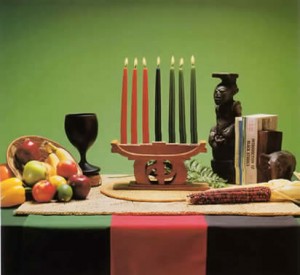 Before writing this article I must confess I had never heard of Kwanzaa–maybe because I’m not American, maybe because I’m white, or maybe just because having been brought up celebrating Christmas, other cultural holidays never really crossed my mind. After a quick hunt online however I found it to be not only widely recognized and celebrated in America, but it struck me as having a cultural significance that made me somewhat ashamed to have ever been ignorant of it.
Before writing this article I must confess I had never heard of Kwanzaa–maybe because I’m not American, maybe because I’m white, or maybe just because having been brought up celebrating Christmas, other cultural holidays never really crossed my mind. After a quick hunt online however I found it to be not only widely recognized and celebrated in America, but it struck me as having a cultural significance that made me somewhat ashamed to have ever been ignorant of it.
Maulana Karenga–an activist, author and professor of Africana studies–established the holiday in 1966 in the midst of the Black Freedom Movement as the first specifically African-American holiday, created due to the necessity he perceived to preserve, revitalize and promote African American culture. The holiday is based around traditional African harvest festivals, the name kwanzaa coming from the Swahili phrase matunda ya kwanza, meaning ‘first fruits of the harvest’. The choice of Swahili is in itself important as it is the most widely spoken language in Africa, and so helps to establish the view of Kwanzaa as an inclusive holiday.
Kwanzaa takes place between the 26th of December and 1st of January with each of the 7 days dedicated to a different principle: unity, self-determination, collective work, cooperative economics, purpose, creativity and faith. Seven candles lit each day of the holiday represent each of the principles. Three of these candles are green, to represent the regeneration of the new year and the fertility of the land, three are red to represent the blood shed in the struggle for freedom, and the central candle is black, standing for the people of Africa themselves.
Originally Karenga described Kwanzaa as an ‘oppositional alternative’ to Christmas and stated that it should not be mixed with the celebration of other holidays to ensure it remained a pure celebration of African heritage–however, as the holiday gained more mainstream attention and following, this exclusive stance was revised and now many families celebrate Kwanzaa alongside Christmas, as a means of honoring their own personal heritage alongside Christmas.
Greetings and gifts are exchanged on each day of the holiday and on the final day there is a large meal, community being a large component of the holiday and it being seen as a chance to reaffirm familial and community bonds. It is not, however, restricted to just the family home‚Äìthere‚Äôs an annual celebration held at the John F Kennedy centre for performing arts that includes interpretative dance and performances of African songs and poems. As well as a time for celebration, it is seen as a serious opportunity to learn more about ones own culture and some families use the chance to engage younger generations in discussions about African principles and history. As the celebration falls on the turn of the new year, the final day of the holiday acts as a chance for sober meditation on three questions: Who am I? Am I really who I say I am? And am I all I ought to be? Thus it’s an opportunity to reflect on the¬†past year and acknowledge those things we may have failed to achieve and should now commit ourselves to.
As well as being a time for personal reflection and improvement, Kwanzaa is used as a means to celebrate and recognize African-American experience as a whole; culture, community, family, history, and so forth. The 2008 film The Black Candle, narrated by Maya Angelou, explores the growth of Kwanzaa from the roots of the Black Power Movement to its current presence as a global, pan-African holiday. To quote the film; “Kwanzaa means access to yourself, it means access to your people…it’s not merely a holiday, it is a statement about a people.”
The necessity of maintaining this celebration should not be underestimated, as in a society that rarely teaches or celebrates African culture, it’s a valuable opportunity to hold those values and history up to the light, as well as instill in younger generations a sense of personal cultural history, and of pride in their heritage.
-Scarlett Evans
Junior Girl
Girl Museum Inc.
